
Minute Man National Historical Park commemorates the opening battle in the American Revolutionary War. It also includes the Wayside, home in turn to three noted American authors. The National Historical Park is under the jurisdiction of the National Park Service and protects 970 acres (392.5 ha) in and around the Massachusetts towns of Lexington, Lincoln, and Concord.
Hubbard House may refer to:

Wright's Tavern is a historic tavern located in the center of Concord, Massachusetts. It is now a National Historic Landmark owned by the Society of the First Parish, Concord, with important associations with the Battle of Lexington and Concord at the start of the American Revolution.
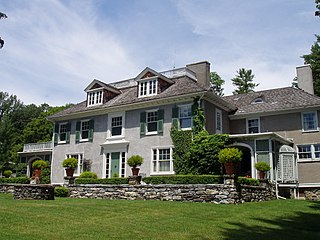
Chesterwood was the summer estate and studio of American sculptor Daniel Chester French (1850–1931) located at 4 Williamsville Road in Stockbridge, Massachusetts. Most of French's originally 150-acre (61 ha) estate is now owned by the National Trust for Historic Preservation, which operates the property as a museum and sculpture garden. The property was designated a National Historic Landmark in 1965 in recognition of French's importance in American sculpture.

The Berkeley Street Historic District is a historic district on Berkeley Street and Berkeley Place in Cambridge, Massachusetts. It encompasses a neighborhood containing one of the greatest concentrations of fine Italianate and Second Empire houses in the city. It was listed on the National Register of Historic Places in 1982, with a substantial increase in 1986.

The Hubbard Park Historic District encompasses a residential development and park west of Harvard Square in Cambridge, Massachusetts. The area was originally the estate of Gardiner Hubbard, who had a 6-acre (2.4 ha) estate and house on nearby Brattle Street. In the 1880s Hubbard commissioned architects to build a ring of high quality homes around his mansion, which was demolished in 1939 and is now the site of Hubbard Park. The houses in this development are now located on Mercer Circle, Sparks Street, and Hubbard Park Road.

The Thoreau–Alcott House is a historic house at 255 Main Street in Concord, Massachusetts, United States that was home to the writers Henry David Thoreau and Louisa May Alcott at different times.

The Concord Monument Square–Lexington Road Historic District is an historic district in Concord, Massachusetts. Monument Square, at the center of the district, was laid out in 1635. The district includes a collection of well-preserved residential houses stretching along Lexington Street southeast from the square, and along Lowell northwest of the square. The square is prominently known as the site of British activities on April 19, 1775, the day of the Battles of Lexington and Concord which began the American Revolutionary War, and of earlier meetings by Massachusetts Patriots which were held in the First Parish Church and Wright's Tavern. The Tavern and the Ralph Waldo Emerson House, which stands near the eastern end of the district, are both National Historic Landmarks. The district was listed on the National Register of Historic Places in 1977.

The Hubbard-Dawson House is a historic house in Holden, Massachusetts. This rambling 2 1⁄2-story wood-frame house is the only surviving instance of Colonial Revival and Queen Anne styling in Holden. The central portion of the house is fairly old, and may date to 1832, when a house was known to be standing on the property. The house at one time had Italianate styling, as evidenced by pre-1890s photographs, which suggest construction from the 1850s, but these decorations appear to have been added onto an architecturally older building. The house is also important for its ownership by Charles Dawson, owner of the Dawson Manufacturing Company, a major local employer between 1872 and 1910.

The Acton Centre Historic District encompasses the historic heart of the once-rural, now suburban, town of Acton, Massachusetts. The district includes properties on Main Street, Wood and Woodbury Lanes, Newtown, Concord, and Nagog Hill Roads, and has been the town's civic heart since its establishment in the 1730s. It was added to the National Register of Historic Places in 1983.

The Sudbury Center Historic District is a historic district on Concord and Old Sudbury Roads in Sudbury, Massachusetts. It was listed on the National Register of Historic Places in 1976. In 1976, it included 80 buildings over 193.6 acres (0.783 km2).

The Parker Village Historic District of Westford, Massachusetts encompasses a historic rural village center. The district extends from the junction of Carlisle Road and Griffin Road, westward along Carlisle Road to a triangular green where it meets Concord Road and Old Lowell Road. The oldest building in the village is the Parker Village Schoolhouse, built in 1787 out of brick and wood, and restored in the 1990s. The majority of the houses in the district date from the 18th and 19th centuries, with eclectic Victorian styles predominating.
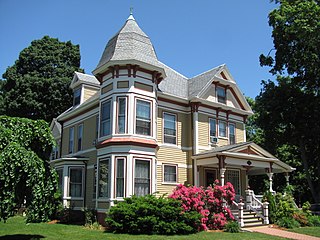
The Woburn Street Historic District of Reading, Massachusetts encompasses a two-block section of late 19th century upper-class housing. The 10-acre (4.0 ha) extends along Woburn Street from Summer Street to Temple Street, and includes sixteen houses on well-proportioned lots along an attractive tree-lined section of the street. The historic district was listed on the National Register of Historic Places in 1985.

The Common Historic District is a historic district encompassing the civic and institutional heart of Reading, Massachusetts. The district is centered on the town common, at the intersection of Main and Salem Streets. The common has been communally owned since at least 1737, with the original burying ground to the north. In 1769 the area's first meeting house was built, giving the area a sense of identity separate from portions of Reading that would later be set off as Wakefield and North Reading. Since then the area has become a focal point for religious and civic institutions in the town.
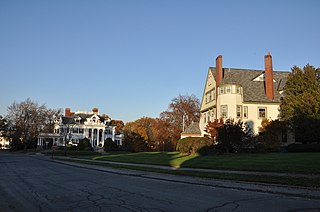
The Belvidere Hill Historic District encompasses a residential area on the east side of Lowell, Massachusetts known for its fine 19th-century houses. The area, roughly bounded by Wyman, Belmont, Fairview, and Nesmith Streets, was developed beginning in the 1850s, and was one of the finest neighborhoods in the city, home to many of its business and civic leaders. It was listed on the National Register of Historic Places in 1995.
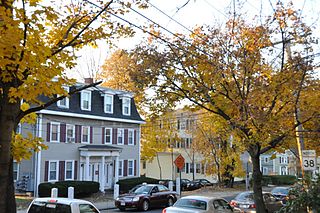
The Washington Square Historic District of Lowell, Massachusetts encompasses a historic subdivision laid out in 1832. The focal point of the subdivision is Kittridge Park, which lies on the eastern side of the district and was an original part of the subdivision plan developed by the Nesmith Brothers. It was the first significant residential subdivision in the city aimed at a wealthier clientele, and was designed by landscape architect Alexander Wadsworth. The district was added to the National Register of Historic Places in 1982, and expanded slightly in 1999.

The House at 6 Adams Street in Wakefield, Massachusetts is one of the best examples of Shingle style architecture in the town. It was designed by Boston architect Robert Pote Wait and built in 1885-86 to be his own home. It was listed on the National Register of Historic Places in 1989.
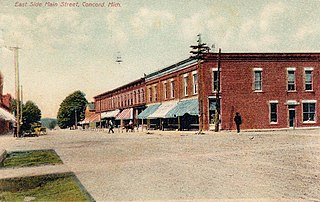
The Concord Village Historic District in Concord, Michigan dates back to 1836, and consists of historic structures located along Hanover Street from Spring to Michigan Streets and North Main Street from Railroad to Monroe Streets. It was listed on the National Register of Historic Places in 1996.

Willard and Josephine Hubbard House is a historic home located at Indianapolis, Indiana. It was built in 1903, and is a 2 1⁄2-story, five-bay, center-hall plan, Italian Renaissance Revival style limestone dwelling with an addition. It features a front wooden portico supported by Ionic order columns and a semi-circular front section. Also on the property is a contributing carriage house / garage.

The Paddock-Hubbard House was built as a single-family home located at 317 Hanover Street in Concord, Michigan. It was listed on the National Register of Historic Places in 1994.






















